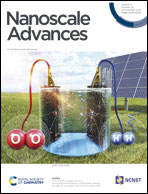Morphology-induced spectral modification of self-assembled WS2 pyramids†
Abstract
Due to their intriguing optical properties, including stable and chiral excitons, two-dimensional transition metal dichalcogenides (2D-TMDs) hold the promise of applications in nanophotonics. Chemical vapor deposition (CVD) techniques offer a platform to fabricate and design nanostructures with diverse geometries. However, the more exotic the grown nanogeometry, the less is known about its optical response. WS2 nanostructures with geometries ranging from monolayers to hollow pyramids have been created. The hollow pyramids exhibit a strongly reduced photoluminescence with respect to horizontally layered tungsten disulphide, facilitating the study of their clear Raman signal in more detail. Excited resonantly, the hollow pyramids exhibit a great number of higher-order phononic resonances. In contrast to monolayers, the spectral features of the optical response of the pyramids are position dependent. Differences in peak intensity, peak ratio and spectral peak positions reveal local variations in the atomic arrangement of the hollow pyramid crater and sides. The position-dependent optical response of hollow WS2 pyramids is characterized and attributed to growth-induced nanogeometry. Thereby the first steps are taken towards producing tunable nanophotonic devices with applications ranging from opto-electronics to non-linear optics.

- This article is part of the themed collection: Supramolecular Chirality in Self-organised Systems and Thin Films


 Please wait while we load your content...
Please wait while we load your content...